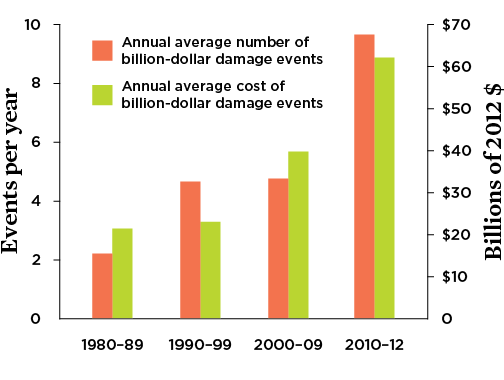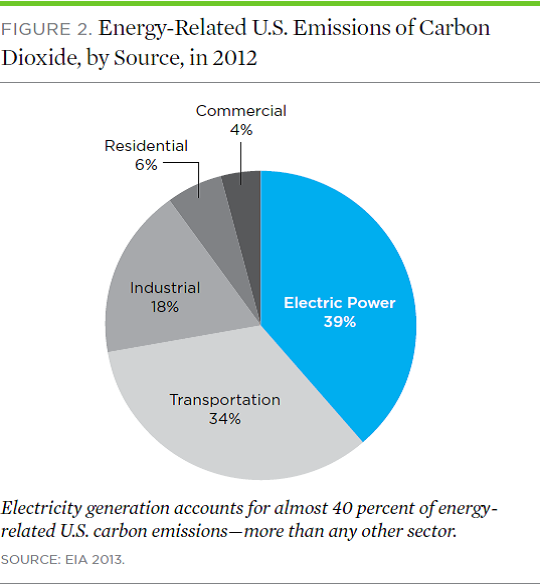Our nation’s aging electricity system is increasingly vulnerable to extreme weather events — including flooding, extreme heat, drought, and wildfires — which often cause power outages. Today UCS released a new report called Power Failure, which describes how extreme weather events are likely to increase in the future as global temperatures continue to rise, with major consequences for the electricity sector.
The report highlights ways to improve our aging electricity infrastructure and reduce the carbon emissions that are heating up the planet. Smart energy choices like energy efficiency and renewables are an important part of the solution — both to make our electricity system more resilient and reliable today, and to reduce the damages and costs of climate change over the long-term.
Extreme weather is increasing
Extreme weather events have become more frequent and costly in recent decades. The average cost of severe weather events has risen from $20 billion per year in 1980 to $85 billion in the 2010s. In 2011 and 2012 alone, 25 extreme weather events caused $188 billion in damages and 1,100 fatalities.

Extreme weather events have become much more common and costly over the past three decades.

Photo: Flickr/dakine kane
Hurricane Sandy put a spotlight on this issue in October 2012. The storm surge caused record flooding along the coasts of New York, New Jersey, and Connecticut. More than 8 million customers across 21 states lost power, and utilities reported damage to some 7,000 transformers and 15,200 poles (like the ones in this picture).
Climate change puts our electricity at even greater risk
Scientists expect the severity of several types of extreme weather to increase as a result of continued climate change. For example:
- Sea level rise threatens coastal facilities. Rising sea levels can make storms and coastal flooding more harmful by allowing more water to reach farther inland. Scientists predict that sea levels will rise between 1.6 and 6.6 feet above 1992 levels by the end of the century. Today some 100 power plants and substations in the contiguous United States are sited within four feet of local high tide, according to a Climate Central study.
- Wildfires pose risks in the western U.S. Wildfires can cause power outages by directly causing damage to transmission poles. Smoke and ash from a wildfire can also create an electrical pathway away from the lines, causing the line to be shut down. The average number of large wildfires per year in the western United States rose from 140 in the 1980s to 250 between 2000 and 2012. Droughts and higher air temperatures also help make wildfires more intense and longer-lasting.
- Power plants are vulnerable to water-related risks. Because thermal power plants rely heavily on water for cooling, a changing climate is likely to put them at high risk from drought and reduced water supplies in some regions and at certain times of the year. Increases in incoming or outgoing water temperatures can also cause power plants to dial back production or even shut down temporarily.
- Droughts and heat waves reduce efficiencies and increase electricity demand. Climate change is already bringing more intense, more frequent, and longer lasting heat waves in North America. Higher air and water temperatures can lead to reduced efficiency at thermal power plants. And as people turn on their air conditioners on hot days, demand for electricity rises, further taxing the system.
Adaptation can help keep the lights on, but is often costly
Because some of the impacts of climate change are unavoidable, the electricity sector will need to adapt to these growing risks. The typical response by utilities to extreme weather events is to invest in so-called “hardening” measures. These include things like burying power lines underground, building protective sea walls, elevating or relocating important equipment like substations, and tree trimming.
While some level of hardening the grid is necessary, these measures are often expensive and may not be the most cost-effective long-term solution. For example, a study by Entergy found that it would cost at least $15 billion from 2010 to 2030 to harden the electric utility systems along the Gulf Coast.
The electricity sector also has a vital role to play in curbing further climate change. Power plants are the leading source of U.S. carbon dioxide emissions — producing nearly 40 percent of the total in 2012 — primarily from burning coal and natural gas.

Renewables and efficiency can make the grid more resilient and reliable
Renewables and efficiency can be win-win solutions that make the electricity grid more resilient AND significantly reduce carbon emissions. For example:
- Renewable energy technologies tend to be smaller and more distributed, greatly reducing the impact on the grid if weather damages them.
- Technologies like wind and solar PV don’t depend on water to produce electricity.
- Renewables are far less vulnerable to interruptions in fuel supplies from extreme weather.
- Energy-efficient homes and businesses require less electricity, deferring or eliminating the need to build new power plants and power lines. Less energy infrastructure means less equipment is vulnerable to damage from extreme weather events.
- Many cities are implementing green and cool roof programs that reduce the urban heat-island effect while reducing the need for air conditioning and improving urban air quality.

After Hurricane Sandy, several power plants were damaged, causing widespread outages. But most wind turbines – like these in Atlantic City, New Jersey — and solar panels didn’t suffer any damage and were producing power after the storm had passed. Photo: Atlantic County Utilities Authority
Recommendations for a more climate-resilient electricity sector
Many solutions are available now to help us better respond to extreme weather and climate change, while also reducing harmful emissions to curb the severity and costs of further warming:
- Cities, counties, and states should conduct vulnerability assessments to evaluate the risks of climate change to their electricity infrastructure.
- State and local governments should require utilities to consider the costs of climate change in long-term planning.
- Power plant owners should install technologies that use less water.
- Utility and grid operators should pursue approaches that make the grid more flexible and better able to integrate renewable energy sources, including expanding transmission capacity.
- State and federal policy makers should adopt and strengthen clean energy policies, such as efficiency and renewable electricity standards.
- The U.S. Environmental Protection Agency should finalize and implement strong power plant carbon standards to reduce emissions from new and existing plants.
